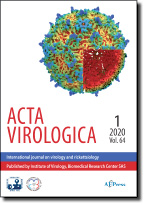Journal info
|
||
Select Journal
Journals
Bratislava Medical Journal Endocrine Regulations General Physiology and Biophysics Neoplasma Acta Virologica Current articles 2023 2022 2021 2020 2019 2018 2017 2016 2015 2014 2013 2012 2011 2010 2009 2008 2007 2006 2005 2004 2003 Studia Psychologica Cardiology Letters Psychológia a patopsych. dieťaťa Kovove Materialy-Metallic Materials Slovenská hudbaWebshop Cart
Your Cart is currently empty.
Info: Your browser does not accept cookies. To put products into your cart and purchase them you need to enable cookies.
Acta Virologica Vol.52, No.2, p.99-106, 2008 |
||
| Title: DETECTION OF HUMAN CYTOMEGALOVIRUS IN THE ATHEROSCLEROTIC CEREBRAL ARTERIES IN HAN POPULATION IN CHINA | ||
| Author: L. YI, J.Y. LIN, Y. GAO, Z.J. FENG, D.X. WANG | ||
| Abstract: The association of atherosclerosis (AS) and Human cytomegalovirus (HCMV) infection was studied. AS plays an important role in the brain stroke and HCMV infection is supposed to be involved in the process of atherosclerotic formation. The presence of HCMV DNA and antigens was examined in the internal carotid arteries collected from 35 patients with ischemic stroke and from 20 patients from the control population. All patients belonged to the ethnic Han population in China. Three methods, immunohistochemistry (IHC), hybridization in situ (HIS), and PCR were used to detect the HCMV immediate early (IE) and late (L) antigens as well as viral DNA in vessel walls. Levels of HCMV IE gene/protein were significantly higher in the stroke group than in control group detected by the three methods (IHC 34.3% vs. 10.0%; HIS 40.0% vs. 10.0; PCR 60.0% vs. 30.0%). However, there was no significant difference in the levels of HCMV L gene/protein between these two groups of patients (IHC 11.4% vs. 5.0%; HIS 11.4% vs. 10.0%; PCR 20.0% vs. 20.0%). We concluded that the presence of HCMV IE antigen and HCMV DNA in the vessel wall was associated with the pathological process of AS formation. |
||
| Keywords: Human cytomegalovirus; atherosclerosis; internal carotid arteries; ischemic stroke | ||
| Year: 2008, Volume: 52, Issue: 2 | Page From: 99, Page To: 106 | |
|
Price:
19.20 €
|
||
|
|
||

